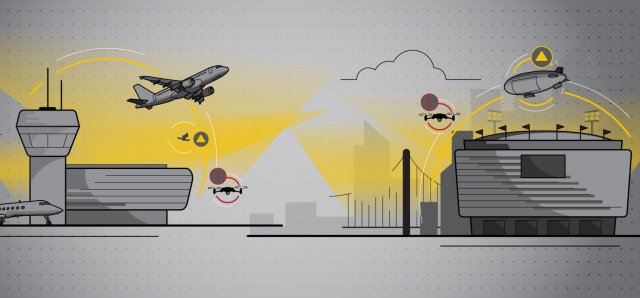Gryphon Sensors, an offshoot of SRC Inc., plans to develop a $10.1 million monitoring system that can detect drones and other small aircraft. The first phase of the project, which is slated for completion in April 2017, will cover the airspace between Gryphon’s North Syracuse headquarters and Griffiss International Airport in Rome, Oneida County.
Gryphon has received a $5.1 million grant from the Empire State Development Corporation as part of the Upstate Revitalization Initiative. The company must pay ESD a $51,000 commitment fee for the grant.
ESD hosted a public hearing on the project Feb. 14 at Cicero Town Hall. Project manager Dave Whitaker explained that Gryphon does not build or fly drones, but the company builds detection systems that use ground radar, cooperative surveillance and downlinked GPS data from drones.
“It’s not just about detecting the drones,” Whitaker added. “It’s also about detecting other things that may be in that corridor that may create a safety hazard, or drones could create a safety hazard for, such as general aviation aircraft.”
Gryphon’s detection system will provide an “agnostic air picture” of the corridor.
“Everything that we can see and we can identify in the area will be provided to all the users, and you really need to do that for a safety case,” Whitaker said. “Where they’re going and all that will not be shared with everybody.
Whitaker said Gryphon’s detection systems can pinpoint items as small as 1/50 of a square meter. A human being is about one square meter on radar.
“In some areas, we’ll be able to see even smaller targets,” he said.
Most of Gryphon’s devices will be mounted on existing buildings to reduce rent and maintenance costs and minimize aesthetic issues.
“We’re trying to make them as less visible as possible,” Whitaker said. “We don’t want a lot of standalone towers or ‘greenfield’ sites.”
Once the Syracuse-Rome phase of the project is complete, Gryphon’s goal is to extend the detection area west to Baldwinsville, north of Oneida Lake and south of the Thruway near Utica. The second phase will cost about $30 million to complete.
Cicero Town Supervisor Mark Venesky told the Star-Review that the Gryphon project will have a “huge” economic impact on the area.
“We need jobs here and we need to build our tax base,” Venesky said. “The project is bigger than just phase one.”
The project has already created 13 new jobs at Gryphon, bringing it to a total of 35 jobs. Gryphon will add seven more employees by the end of phase one.
According to ESD, the economic benefits of this project (fiscal plus total net resident disposable income from project employment) will total $41,927,855. For each permanent job created by the Gryphon project, ESD projects that 1.58 indirect jobs will be generated for New York state’s economy.
Last summer, online shopping juggernaut Amazon announced its plans for drone delivery in the U.S., the United Kingdom, Austria and Israel. In December, Flirtey, a drone-delivery startup, tested delivery of 77 packages from a 7-Eleven store in Reno, Nevada, claiming they could deliver a Slurpee without losing a single drop.
Gryphon’s drone detection system could attract such businesses to Central New York.
“The ultimate goal of this is to provide a unique … facility that will attract businesses from around UAS infrastructure, not just the drone manufacturers but also users of drones,” Whitaker said. “The longer-term leverage of this is job creation from other industries. … It’s really attracting companies to utilize this particular infrastructure — the Amazons of the world, for example.”
Whitaker said businesses that use drones could help build “use cases,” or testing and demonstrations to prove that drone usage is safe.
“One of the unique benefits of this area is … it will basically have all the environments for just about any use case that’s currently conceived,” Whitaker said, “anywhere from law enforcement-type applications, search and rescue-type applications, product delivery, linear inspections for railroads and pipelines.”
Whitaker said laws governing aviation have not yet caught up to the proliferation of drones in the last few years.
“It took about 100 years to get from the beginning of aviation to 325,000 registered aircraft in the United States,” he said. “It took less than two years from the beginning of the commercial drone era to a million drones.”
Source: Eagle News

